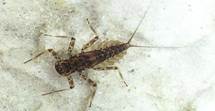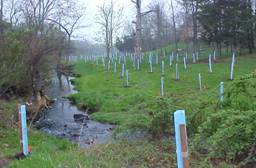

Overseeing the Water Resources of Loudoun County, VA
Environmental Stewardship
The federal Clean Water Act of 1972 guarantees citizens the right to be informed about the quality of their drinking and recreational waters, and to help keep these waters healthy. Water quality standards establish numerical criteria for the safe use of waters for aquatic life, drinking, swimming, fishing, and boating. The intent is to limit pollutants entering a stream so degradation that prevents these uses does not occur.

Stream restoration in Big Springs

Mayfly Nymph
A healthy stream does not exist in isolation. Rather, it is the lowest point in an interconnected complex of ecosystems, and is influenced by land uses around it. Keeping excessive sediments, nutrients, organic materials, and harmful chemicals and bacteria out of streams requires the application of best management practices (BMPs). These BMPs need to be applied to the immediate stream banks, the drainage areas along the streams, and throughout the upstream drainage area.

Stream restoration in Ashburn

Stream clean-up on Catoctin Creek
info@loudounwatershedwatch.org Copyright © 2011 Loudoun Watershed Watch